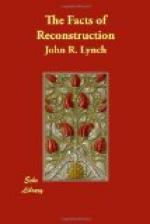In this, however, we were sadly disappointed. The result of the first vote for Speaker of the House was as follows:
Lynch, Republican caucus nominee 55 Streeter, Democratic nominee 47 Chandler, Independent Republican 7 Armstead, Independent Republican 1 Howe, Regular Republican 1 Necessary to elect 56
Judge Chandler of Noxubee, who had been elected as a regular Republican with four other white Republicans,—all of whom attended and took part in the caucus the night before,—refused to vote for the nominee of the caucus for Speaker but voted instead for Chandler. It will be seen that the vote for Streeter, the Democratic caucus nominee, was two less than that party’s strength; thus showing that two Democrats must have also voted for Chandler. It will also be seen that if every vote that was not received by Lynch had been given to Chandler or to any other man, that man would have received the required number of votes and would have been elected. The Democrats stood ready to give their solid vote to any one of the Independents whenever it could be shown that their votes would result in an election. But it so happened that Chandler and Armstead were both ambitious to be Speaker and neither would give way for the other, which, of course, made the election of either impossible. The one vote cast for Howe was no doubt Mr. Armstead’s vote, while the one vote for Armstead was no doubt cast by his colleague. In the nomination of Hon. H.M. Streeter, the Democrats selected their strongest man, and the best parliamentarian on their side of the House. The refusal of the so-called Independents to vote for the Republican caucus nominee for Speaker produced a deadlock which continued for a period of several days. At no time could any one of the regular Republicans be induced under any circumstances to vote for any one of the Independents. They would much rather have the House organized by the Democrats than allow party treachery to be thus rewarded.
While the deadlock was in progress, Senators Alcorn and Ames suddenly made their appearance upon the scene of action. They had made the trip from Washington to use their influence to break the deadlock, and to bring about an organization of the House by the Republican party. But Senator Alcorn was the one that could render the most effective service in that direction, since the bolters were men who professed to be followers of his and loyal to his political interests and leadership.
As soon as the Senator arrived he held a conference with the bolters, including Messrs. Armstead and Streeter,—the two independents from Carroll. In addressing those who had been elected as Republicans and who had attended and participated in the caucus of that party, the Senator did not mince his words. He told them in plain language that they were in honor bound to support the caucus nominees of their party, or that they must resign their seats and allow their




